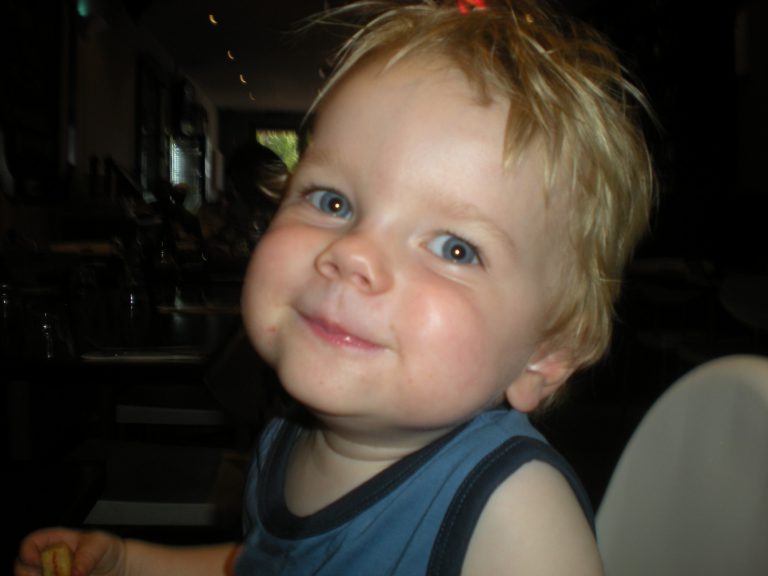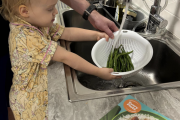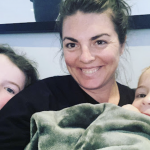“He Said What”?

I have a gorgeous, busy and talkative 2 year old boy who, while more often than not, drives me completely crazy, is also very entertaining and says the funniest things.
Today was no exception. We were out for our morning coffee together at our local café where Mister 2 is extremely comfortable. I think he sees it sometimes as his second home (well mum does love her coffee!!) running ahead, finding our usual spot to sit and waiting to order his morning tea. Today his choice was “a tino and a fartie tootie”, translation a chino and a smartie cookie. While the waitress and I had a bit of a laugh over this, I must admit this was not the first time his pronunciation of sounds had resulted in the need for hasty translations from me. Take for instance not too long ago at the bank. Mister 2 has an absolute obsession with trains and dump trucks and he will talk for hours about them to anyone who will listen. He was particularly excited this day as he had seen many big huge dump trucks on our travels. He was excitedly telling the rather conservative bank teller all about them when she looked at me and said “Excuse me, He said what???” You see “dump truck” came out as well, “dumb (you can guess the other word) so all she heard was “huge big dumb (insert expletive here),” and well I’m sure you can guess she was not impressed! After some fast talking, all was right in the world, but I knew this would not be the last time I would have to translate for my little boy and I also know that were thousands of parents around the world needing to do exactly the same thing. But as with all areas of development, children develop their speech sounds at their own pace and some sounds and sound combinations are more challenging than others, taking longer for the child to master.
So at what age do children acquire what sounds? Here is a guide below:
By age 1: Sounds b; m; d; n; h; w; t. Babies will use these sounds in the form of babbling. They will simplify words such as “bu” for “bubbles”.
By age 2: Sounds b; p; m; n; h; w; d; t. It is not unusual for your child to still be difficult to understand by you and especially by unfamiliar listeners.
By age 3-3.5yrs: Above sounds plus the sounds g; ng; y; k; l. Your child should be able to be understood by you most of the time and by unfamiliar adults approximately 75-80% of the time.
By age 4-4.5yrs: Above sounds plus the sounds l; sh; ch; s; z; j. Your child may still have difficulty saying all the sounds in words that are long. eg: “hippopotamus”.
By age 5yrs: Above sounds plus the sound “r”. Your child should be able to be understood by pretty much everyone by this age.
By age 6yrs: Above sounds plus the sound “v”. Generally between the ages of 4-6 years children will also master clusters of sounds together such as “bl” for “blue” or “tr” for” truck”.
By age 7-8yrs: Above sounds plus the sound “th”
As mentioned before, children develop their sounds at their own rate, however this guide demonstrates the age at which around 75% of children will correctly produce these sounds. These milestones can help you and speech pathologists determine whether your child may need some speech pathology intervention. If you are at all concerned with your child’s speech and you don’t feel they are developing their speech sounds similarly to the above ages or if they continue to be difficult to understand after the age or 3 years, then it may be appropriate for you to seek some advice from a speech pathologist.
Going by the above guide I’ve got at least another 2 years’ worth of translating to do!
Kath Keiper is the co-creator of three beautiful children who while driving her crazy, make her laugh everyday. Having been a paediatric speech pathologist for over 15 years, Kath has also spent her life dedicated to helping children and families. Through her career Kath has been fortunate to speak at varying events such as the World Autism Congress and Speech Pathology Australia. Being able to make a positive difference in many children and families lives has always been Kath’s highlight. Her love of helping children, making a difference and performing, have also been the driving force behind the creation of her first DVD for children “Can you sound like me?”
Visit www.chewchewchatter.com.au










